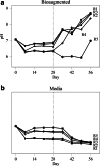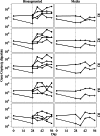Laboratory-scale bioaugmentation relieves acetate accumulation and stimulates methane production in stalled anaerobic digesters
- PMID: 26481626
- PMCID: PMC4703610
- DOI: 10.1007/s00253-015-7058-3
Laboratory-scale bioaugmentation relieves acetate accumulation and stimulates methane production in stalled anaerobic digesters
Abstract
An imbalance between acidogenic and methanogenic organisms during anaerobic digestion can result in increased accumulation of volatile fatty acids, decreased reactor pH, and inhibition of methane-producing Archaea. Most commonly the result of organic input overload or poor inoculum selection, these microbiological and biochemical changes severely hamper reactor performance, and there are a few tools available to facilitate reactor recovery. A small, stable consortium capable of catabolizing acetate and producing methane was propagated in vitro and evaluated as a potential bioaugmentation tool for stimulating methanogenesis in acidified reactors. Replicate laboratory-scale batch digesters were seeded with a combination of bioethanol stillage waste and a dairy manure inoculum previously observed to result in high volatile fatty acid accumulation and reactor failure. Experimental reactors were then amended with the acetoclastic consortium, and control reactors were amended with sterile culture media. Within 7 days, bioaugmented reactors had significantly reduced acetate accumulation and the proportion of methane in the biogas increased from 0.2 ± 0 to 74.4 ± 9.9 % while control reactors showed no significant reduction in acetate accumulation or increase in methane production. Organisms from the consortium were enumerated using specific quantitative PCR assays to evaluate their growth in the experimental reactors. While the abundance of hydrogenotrophic microorganisms remained stable during the recovery period, an acetoclastic methanogen phylogenetically similar to Methanosarcina sp. increased more than 100-fold and is hypothesized to be the primary contributor to reactor recovery. Genomic sequencing of this organism revealed genes related to the production of methane from acetate, hydrogen, and methanol.
Keywords: Acetoclastic; Anaerobic digestion; Bioaugmentation; Methanogen; Thermophilic.
Figures




Similar articles
-
Assessment of hydrogen metabolism in commercial anaerobic digesters.Appl Microbiol Biotechnol. 2016 May;100(10):4699-710. doi: 10.1007/s00253-016-7436-5. Epub 2016 Mar 19. Appl Microbiol Biotechnol. 2016. PMID: 26995607
-
Upflow anaerobic sludge blanket reactor--a review.Indian J Environ Health. 2001 Apr;43(2):1-82. Indian J Environ Health. 2001. PMID: 12397675 Review.
-
Molecular characterization of anaerobic digester microbial communities identifies microorganisms that correlate to reactor performance.Bioresour Technol. 2014 Jan;151:249-57. doi: 10.1016/j.biortech.2013.10.070. Epub 2013 Oct 30. Bioresour Technol. 2014. PMID: 24246480
-
Bioaugmentation of syntrophic acetate-oxidizing culture in biogas reactors exposed to increasing levels of ammonia.Appl Environ Microbiol. 2012 Nov;78(21):7619-25. doi: 10.1128/AEM.01637-12. Epub 2012 Aug 24. Appl Environ Microbiol. 2012. PMID: 22923397 Free PMC article.
-
Bioengineering of anaerobic digestion for volatile fatty acids, hydrogen or methane production: A critical review.Bioengineered. 2019 Dec;10(1):437-458. doi: 10.1080/21655979.2019.1673937. Bioengineered. 2019. PMID: 31570035 Free PMC article. Review.
Cited by
-
Metataxonomic characterization of the microbial community involved in the production of biogas with microcrystalline cellulose in pilot and laboratory scale.World J Microbiol Biotechnol. 2023 May 6;39(7):184. doi: 10.1007/s11274-023-03573-9. World J Microbiol Biotechnol. 2023. PMID: 37147463
-
Directional Selection of Microbial Community Reduces Propionate Accumulation in Glycerol and Glucose Anaerobic Bioconversion Under Elevated pCO2.Front Microbiol. 2021 Jun 16;12:675763. doi: 10.3389/fmicb.2021.675763. eCollection 2021. Front Microbiol. 2021. PMID: 34220760 Free PMC article.
-
Optimization of biogas yield from lignocellulosic materials with different pretreatment methods: a review.Biotechnol Biofuels. 2021 Jul 19;14(1):159. doi: 10.1186/s13068-021-02012-x. Biotechnol Biofuels. 2021. PMID: 34281615 Free PMC article. Review.
-
Soil-Derived Inocula Enhance Methane Production and Counteract Common Process Failures During Anaerobic Digestion.Front Microbiol. 2020 Oct 20;11:572759. doi: 10.3389/fmicb.2020.572759. eCollection 2020. Front Microbiol. 2020. PMID: 33193175 Free PMC article.
-
Non-autotrophic methanogens dominate in anaerobic digesters.Sci Rep. 2017 May 4;7(1):1510. doi: 10.1038/s41598-017-01752-x. Sci Rep. 2017. PMID: 28473726 Free PMC article.
References
Publication types
MeSH terms
Substances
LinkOut - more resources
Full Text Sources
Other Literature Sources
Molecular Biology Databases

